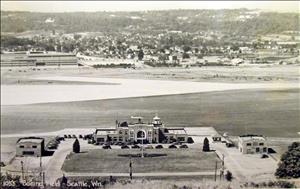On July 26, 1928, Seattle's first municipal airport is dedicated. Located south of the city, it is named Boeing Field because of the Boeing Airplane Company's proximity and because Boeing's Pacific Air Transport (later United Airlines) uses it for regular airmail service.
The Happiest Day
At the dedication, State Representative W. W. Conner tells 20,000 people, "Boeing Field today means more to Seattle and the Northwest than the building of the old Yesler Wharf meant to our pioneer citizens." Boeing president William E. Boeing (1881-1956) announces, "This day is just about the happiest one of my life."
Seattle's first domestic air mail had arrived in 1926 aboard a Pacific Air Transport plane, which landed on the small test field near Boeing's "Red Barn" west of the Duwamish Waterway. Boeing won its own national air mail contract a year later (planting the seed for United Airlines), just as the Navy took over King County's Sand Point field, then the region's major landing strip. The company threatened to relocate to Los Angeles unless local government built a proper airport quickly.
In July 1927, the Seattle Chamber of Commerce Aviation Committee investigated six sites in King County for a municipal airport and selected a seventh location east of the Duwamish River. The area of Boeing Field was well served by three rail lines and by Highway 99 and it was near water for use by seaplanes. Runway construction began on March 28, 1928, with fill from dredging the Duwamish River. Labor included sentenced prisoners among whom were six men serving sentences as "lazy husbands."
On May 14, 1929, the first large hangar was dedicated. In 1930, the Boeing Hanger and the administration building and restaurant were completed. By 1935, the U.S. Bureau of Air Commerce already had begun to contemplate construction of a new super airport in a different King County location because of the hazards posed by the high ridge to the east of Boeing Field.
The Sea-Tac Era Begins
At the beginning of World War II, scheduled air service was moved briefly to Paine Field. By the late 1940s, most airlines had moved to the new Sea-Tac airport (opened in 1944 but not officially dedicated until 1949). This left the Boeing facility to serve general, charter, and Boeing aviation activities.
The last scheduled air service to Boeing Field ended in 1971.

